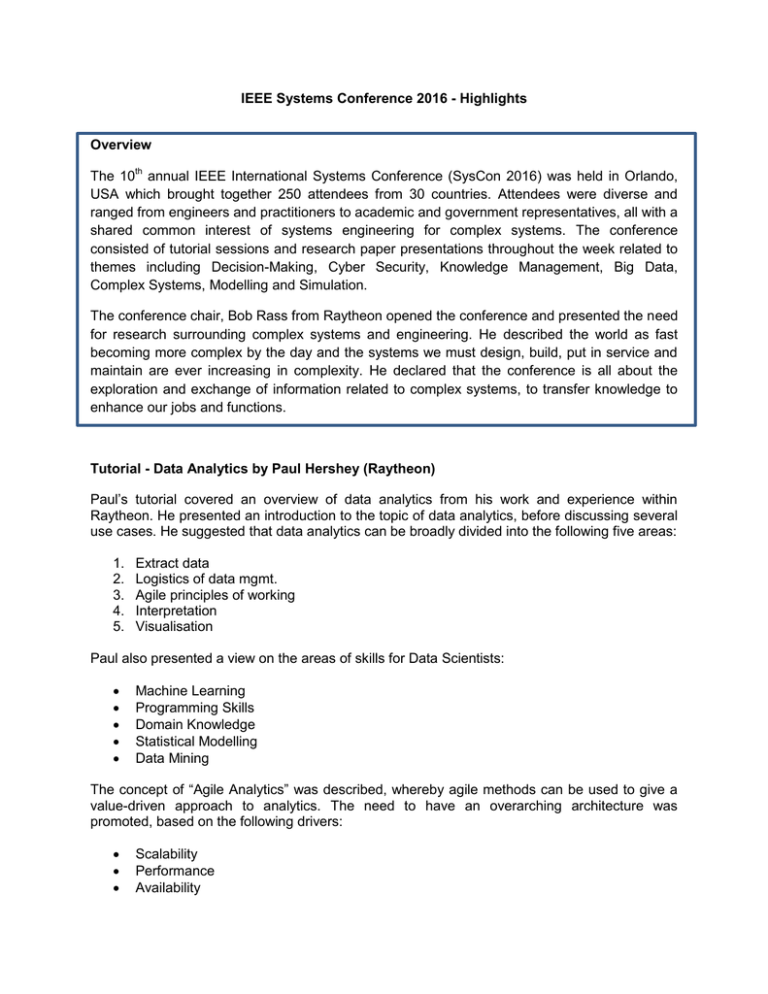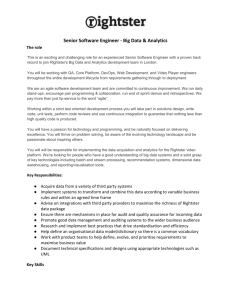IEEE Systems Conference 2016 - Highlights Overview The 10th
advertisement

IEEE Systems Conference 2016 - Highlights Overview The 10th annual IEEE International Systems Conference (SysCon 2016) was held in Orlando, USA which brought together 250 attendees from 30 countries. Attendees were diverse and ranged from engineers and practitioners to academic and government representatives, all with a shared common interest of systems engineering for complex systems. The conference consisted of tutorial sessions and research paper presentations throughout the week related to themes including Decision-Making, Cyber Security, Knowledge Management, Big Data, Complex Systems, Modelling and Simulation. The conference chair, Bob Rass from Raytheon opened the conference and presented the need for research surrounding complex systems and engineering. He described the world as fast becoming more complex by the day and the systems we must design, build, put in service and maintain are ever increasing in complexity. He declared that the conference is all about the exploration and exchange of information related to complex systems, to transfer knowledge to enhance our jobs and functions. Tutorial - Data Analytics by Paul Hershey (Raytheon) Paul’s tutorial covered an overview of data analytics from his work and experience within Raytheon. He presented an introduction to the topic of data analytics, before discussing several use cases. He suggested that data analytics can be broadly divided into the following five areas: 1. 2. 3. 4. 5. Extract data Logistics of data mgmt. Agile principles of working Interpretation Visualisation Paul also presented a view on the areas of skills for Data Scientists: Machine Learning Programming Skills Domain Knowledge Statistical Modelling Data Mining The concept of “Agile Analytics” was described, whereby agile methods can be used to give a value-driven approach to analytics. The need to have an overarching architecture was promoted, based on the following drivers: Scalability Performance Availability Reliability Manageability Cost Paul also recommended an influential book written by Martin Fowler entitled “Thinking about Big Data”. --Tutorial - Intelligent Control Architecture for Autonomous Vehicles by Dr Carlos C. Insaurrable (Teeside University) Carlos’ tutorial presented a comprehensive and detailed view on control architectures for unmanned vehicles. The tutorial was based on the four architectural pillars for autonomy, namely: 1. Robot Control Architecture a. Hierarchical (deliberate) b. Behavioural (reactive) c. Hybrid (combination of deliberate and reactive) 2. Knowledge Representation 3. Agent Architecture a. Reactive b. Deliberate c. Layered/Hybrid d. Cognitive 4. Situation Awareness (OODA and APIE loops) a. Decision-Making b. Decision-Enforcing Carlos provided many examples and provided a detailed view into the application of such intelligent control architectures for autonomous vehicles. --Presentation Highlights Keynote - Model- and Component-Based Design of Cyber-Physical Systems by Janos Sztipanovits (Inst. for Software Integrated Systems, Vanderbilt University) The keynote speaker described the challenges and approaches to building a comprehensive design automation tool suite for complex cyber-physical systems (CPS). He argued that cyberphysical systems is a new term for systems engineering, or is at least a branch of systems engineering. He defined CPS as engineering systems where functionality emerges from the networked interaction of physical and computational processes. He proposed the need for such work when there are new industry-driven platforms for creating complex CPS emerging, such as Internet of Things (IoT). He presented several examples of work related to DARPA and the use of the CyPhyML modelling integration language. There were 157 papers that were accepted for the conference of the 343 that were submitted for peer review (60% acceptance rate). I presented the paper on ‘Route Networks within the Air Transport System’ of a study undertaken on flight data using a network analysis approach. The conference also provided an opportunity to network with researchers and practitioners in this area. The remaining papers were also presented throughout the course of the conference, of which there were some stand-out work related to my research and interests. John Salmon’s work from Brigham Young University, showed the investigation into the optimal locations of charging stations if New York Taxis were to shift to electric vehicles. The work of gamification and game-based learning by the University of Alabama in Huntsville showed how such approaches can be used within complex systems to teach (game-based learning) and to incentivise through the use of game design elements. The presentation by Steven’s Inst. of Technology on the use of interactive visualisation for decision-making for complex systems, presented the appropriate situations for using interactive visualisations. The latest in Systems Engineering knowledge was presented by Claus Nielsen from Cranfield University, promoting the SEBOK (Systems Engineering Body of Knowledge) and the GRCSE (Graduate Reference Curriculum for Systems Engineering) which are aimed to capture the knowledge from systems engineering work for researchers and practitioners. Further information on this and wider systems research can be found at www.bkcase.org.


